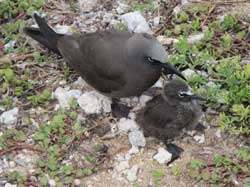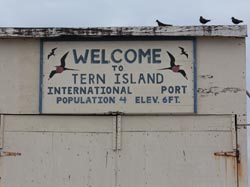
Reef Assessment and Monitoring Program Expediton Log – August 5, 2012
Bird is the Word!
By: Megan Onuma & Carlie Wiener, COSEE Island Earth
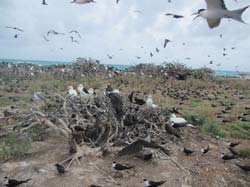
Birds that spend most of their lives flying all over the Pacific Ocean come back to nest on Tern Island. Credit: C. Wiener
Sometimes life throws you rare opportunities, and our visit to Tern Island was one of those moments. Tern Island is a small 30-acre, sandy islet at French Frigate Shoals, which also happens to be one of the largest tropical seabird rookeries in the world. This means that birds rule the island, so if you ever wondered what it was like to be a sea bird, then this is the island for you!
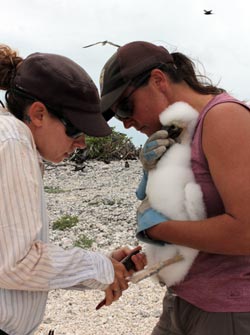
Meg Duhr, U.S Fish & Wildlife Service refuge manager for Tern Island bands a Boobie chick with volunteer. Credit: C. Wiener
Upon arrival, the thick smell of guano (bird poo) permeated the air, and the sheer number and diversity of sea birds hovering overhead was overwhelming. U.S. Fish and Wildlife Service refuge manager for Tern Island, Meg Duhr, escorted us by boat to this special place. Meg has the unique job that allows her to live on the remote island along with three other volunteers. Walking around Tern, you really understand how important this small piece of sand is to the entire seabird population. Millions of sea birds come here to lay their eggs and produce chicks. Masked Booby's, the darting Sooty Tern, and even a few Laysan Albatrosses can all be found here. This time of year many of the chicks have fledged (learned to fly and leave the island); however, we still got to encounter several chicks awkwardly waddling around as they learn to use their bodies. This was an excellent opportunity to see how the volunteer staff tracks the sea bird population using banding techniques - a method that uses a jail-like bracelet with an identification number that is placed on the bird's leg. This is a harmless and non-invasive way to see where these birds go, and if they return. Banding of the sea bird population in the Northwestern Hawaiian Islands has been used to monitor the populations for the last thirty years.
Old U.S. military barracks is where Meg calls home, and showed us all the hard work that is needed to keep the island up and running. Treating rain water from catchments, keeping track of the energy consumption which they receive from solar panels, and combing the island daily for injured monk seals, sea birds and turtles that may need assistance, are all just part of the call of duty. Meg is passionate about what she does and notes the increase in birds since the old runway on the island has stopped being used by planes. In the past year and a half, they have seen a dramatic increase in nesting bird habitat by using areas of the old runway that have begun to sprout vegetation. As we toured along the runway, a giant frigate bird abruptly snapped its beak and ingested a whole sooty tern. This is the real deal where remote island life can be harsh, any extra habitat or advantages that these birds have is critical. This also applies to the endangered Hawaiian monk seals and green sea turtles that use East Beach on Tern Island for pupping and laying eggs.
While there are very few dedicated staff for this special place, those who come here for research, or to volunteer are committed to the island and the species that call it home. Anyone who sees this unique and remote island can surely understand its importance to a variety of species, and most importantly to these mysterious and agile sea bird populations.
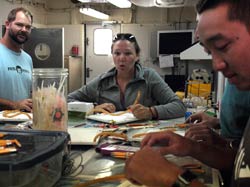
Trying to identify fish species can sometimes be difficult – scientists gather data and prepare slates for next dive trip. Credit: C. Wiener
Next on the ship itinerary is Pearl and Hermes atoll. The ship will leave French Frigate Shoals this evening and begin its three day transit. In this time scientist will regroup to analyze and back up their data and help to process any samples or recordings. Life out at sea is really a balance of long transits filled with data entry and prep work contrasted against exciting field expeditions in the pristine coral reefs.
Click here to go back to the Expedition Log.
